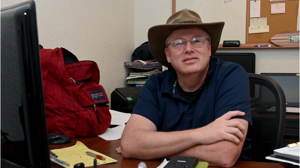
30 Mar Invisible spectrum, visible results: Air Force veteran continues service at U.S. Army Yuma Proving Ground
YUMA — Even in an organization where it is common to find people who are passionate about their work, Michael Stoltenberg, Electronic Warfare Radiofrequency Support Lead at U.S. Army Yuma Proving Ground (YPG), stands out.
“He’s very passionate about what he does,” said Justin Croutch, Cross Functional Team Integrator. “You can tell he really understands what he is doing and thoroughly enjoys it.”
The Air Force veteran has worked at YPG for 15 years, and sees his civilian career as a continuation of his duties while in uniform.
“I was an instrumentation and telemetry technician, pretty much the same job I do here,” said Stoltenberg. “There were only 600 of us in the entire Air Force, and none of us were allowed overseas. It was heavily focused on research and development.”
The Orange County, California native liked drafting and drawing growing up, so started pursuing classes toward an architecture degree at Fullerton College. When he was 21, however, his life changed unexpectedly.
“My college dropped my major and I needed some time to think and figure out what I was going to do with my life.”
He enlisted in the Air Force and scored high on his Armed Services Vocational Aptitude Battery tests. When offered his choice of military occupational specialties, he chose based on his already-long years of tinkering with electronics: the Radio Shack catalog was a longstanding companion throughout his youth.
“I actually built my own satellite dish when I was a kid,” he recalled. “I was re-wiring tools but didn’t understand electricity at the level I should have. I think I ended up in electronics because I kept electrocuting myself as a kid: I wanted to learn how to not electrocute myself.”
While assigned to the 746th Test Squadron at Holloman Air Force Base, New Mexico, he had dealings with testing conducted at White Sands Missile Range, part of the Army Test and Evaluation Command, and through this experience first heard of YPG. After his enlistment was up, he went to University of Arizona, graduated in 2006, and quickly found work in the private sector, only to get laid off during the Great Recession in 2008. Already familiar with YPG, he found work here as a contractor for the-then National Counterterrorism Counterinsurgency Integrated Test and Evaluation Center (NACCITEC), which was working feverishly to field counter-improvised explosive device electronic systems into Iraq and Afghanistan. He became a government civilian working in his current branch in 2011.
Though YPG does not have to contend with encroachment from houses and buildings, it is not exempt from the crowded radio spectrum that facilitates much of modern life. Every time you use a cell phone, microwave oven, or garage door opener, you are using parts of the radio spectrum, the invisible resource that YPG relies on to support their highly specialized testing, from using radar and telemetry in evaluation of artillery rounds to replicating the radio spectrum as it is in various places around the world to facilitate the testing of technologies to counter unmanned aircraft.
“A lot of testing involves really complex, dense radio frequency environments. If a system under test doesn’t work, the customer can go back to the bench and work on it, and when they come back we can put up the exact same environment they used last time.”
Part of Stoltenberg’s job involves identifying the causes of potential spectrum conflict on the test range and finding solutions to allow the mission to proceed.
“Spectrum is a precious resource. If I can’t change the frequency, I can change the time of day or locations for two conflicting tests. It may solve the issue, but we still have to get approvals from the FCC and FAA.”
Toward this end, the tools of his trade to conduct radio frequency investigations on the range include handheld spectrometers and GPS tools. If testers experience radiofrequency dropouts on the range, he can make a computer model to predict a good alternate location for their activities. More important, though, is modeling and coordination to prevent conflicts from occurring.
“We talk regularly to keep each other in the loop so we are not interfering with each other. The idea is to keep ensure the safety of individuals and the security of communications.”
He also assists YPG’s Cold Regions Test Center at Fort Greely, Alaska and Tropic Regions Test Center (TRTC) in Central and South America. When TRTC conducted a major test of the Armored Multipurpose Wheeled Vehicle (AMPV) in Central America last year, he helped the test team with their communication devices they needed conduct operations safely in a triple canopy jungle.
“We made sure all of their equipment worked here before they shipped it down there. They went down and everything worked well.”
Off duty, he plans to pursue a Master’s Degree in applied physics soon, and still tinkers with electronics just as he did in his youth.
“It’s what I like to do,” he said. “I’m teaching my son about RF. I have my own equipment at home that I’ve picked up over the years.”
